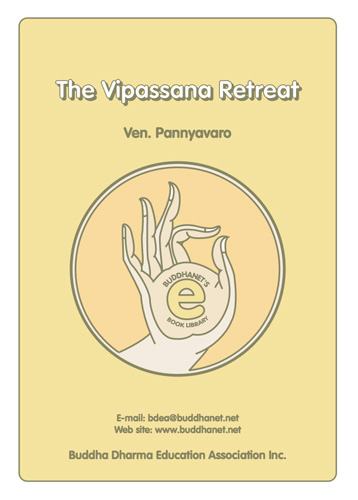 Top rated - eBook Library Top rated - eBook Library |

mission-accomplished.pdfThe Mission Accomplished2079 viewsA historical analysis of the Mahaparinibbana Sutta of the Digha Nikaya of the Pali Canon. The Mission Accomplished is undoubtedly an eye opening contribution to Buddhist analytical Pali studies. In this analytical and critical work Ven. Dr. Pategama Gnanarama enlightens us in many areas of subjects hitherto unexplored by scholars. His views on the beginnings of the Bhikkhuni Order are interesting and refreshing. They might even be provocative to traditional readers, yet be challenging to the feminists to adopt a most positive attitude to the problem. Prof. Chandima Wijebandara, University of Sri Jayawardhanapura, Sri Lanka.    
(6 votes)
|
|

damachak.pdfDhammacakkappavattana Sutta5058 viewsVen. Mahasi Sayadaw
The First Discourse of the Buddha, namely the Dhammacakkappavattana Sutta, commonly known as the Great Discourse on the Wheel of Dhamma. This is a series of discourses on the Dhammacakka Sutta by the late Venerable Mahasi Sayadaw, a Questioner at the Sixth Buddhist Council in Myanmar, (Burma) 1954. Translated by U Ko Lay.    
(6 votes)
|
|

nibbana1.pdfThe Practice which Leads to Nibbana3252 viewsVen. Pa-Auk Sayadaw
Translated by Greg Kleiman. This is the method of practising meditation that is taught at Pa Auk Tawya Monastery, (Myanmar) Burma. It is based on the explanation of meditation found in the Visuddhimagga commentary. Because of that the method involves several stages of practice which are complex, and involved. These stages include a detailed analysis of both mentality and matter, according to all the categories enumerated in the Abhidhamma, and the further use of this understanding to discern the process of Dependent Origination as it occurs in the Past, Present, and Future. Therefore people who are unfamiliar with the Visuddhimagga and the Abhidhamma will have difficulty in understanding and developing a clear picture of the practice of meditation at Pa Auk Tawya. For foreigners who cannot speak Burmese this problem is made even more difficult. This introduction has been written to help alleviate these difficulties by presenting a simplified example of a successful meditator's path of progress as he develops his meditation at Pa Auk Tawya.    
(6 votes)
|
|

v_retreat6.pdfThe Vipassana Retreat4049 viewsVen. Pannyavaro
Vipassana meditation requires long-term commitment. While it can be done to some extent in everyday life, realistically for the practice to deepen it needs to be done intensively in a supportive retreat situation. Vipassana meditation is developmental, so to realise its ultimate benefit it has to be sustained with appropriate intensity under supportive conditions. Ven. Pannyavaro, a practitioner of over 30 years, guides you through the vipassana experience in a retreat situation, in a systematic and practical way.    
(6 votes)
|
|

10_Culture_web.pdfVolume 10. Korean Buddhist Culture1448 viewsAccounts of a pilgrimage, monuments, and eminent monks.    
(3 votes)
|
|

geth0401.pdfCan Killing a Living Being Ever Be an Act of Compassion?4004 viewsThe analysis of the act of killing in the Abhidhamma & Pali Commentaries.
Abstract: In the Theravadin exegetical tradition, the notion that intentionally killing a living being is wrong involves a claim that when certain mental states (such as compassion) are present in the mind, it is simply impossible that one could act in certain ways (such as to intentionally kill). Contrary to what Keown has claimed, the only criterion for judging whether an act is “moral†(kusala) or “immoral†(akusala) in Indian systematic Buddhist thought is the quality of the intention that motivates it. The idea that killing a living being might be a solution to the problem of suffering runs counter to the Buddhist emphasis on dukkha as a reality that must be understood. The cultivation of friendliness in the face of suffering is seen as something that can bring beneficial effects for self and others in a situation where it might seem that compassion should lead one to kill.    
(3 votes)
|
|

gqga_khamer.pdfGood Question, Good Answer (Cambodian)2340 viewsKhmer (Cambodian) edition of Ven. Dhammika's Good Question, Good Answer. Translator: Bhikkhu S. Vodano.    
(3 votes)
|
|

04_vibhanga.pdf04 Dependent Arising: Vibhanga3266 viewsLooking at the standard "twelvefold formula" of dependent arising,and the question of life-after-life, or "rebirth.    
(3 votes)
|
|

ctp_book_v1.pdfClearing the Path2291 viewsNOTE: Primarily the PDF CtPbookV1.pdf is made to be printed as a book. Other versions of this PDF are modified to be better viewed on screen - whilst another is already pre-printed in PDF format as a 2-up meaning that there are 2 pages per A4 Landscape oriented page to make for easier printout (on A4 paper) for personal use.    
(3 votes)
|
|

dhammapada_illustrated.zipTreasury of Truth2429 viewsThis is the Illustrated version of the Dhammapada or Treasury of Truth, compiled by Venerable Weragoda Sarada Maha Thero.    
(3 votes)
|
|
| 290 files on 29 page(s) |
 |
 |
 |
18 |  |
 |
 |
|
